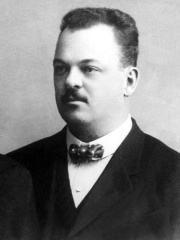
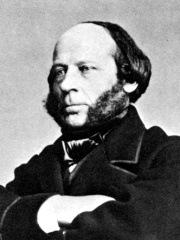
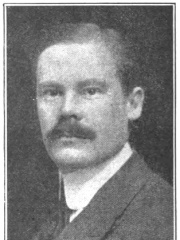
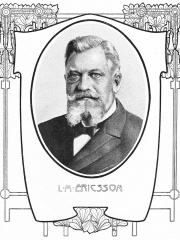
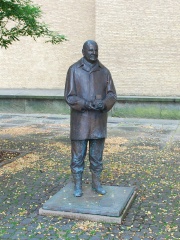
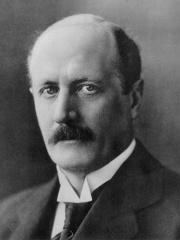

The Most Famous
INVENTORS from Sweden
Top 8
The following people are considered by Pantheon to be the most legendary Swedish Inventors of all time. This list of famous Swedish Inventors is sorted by HPI (Historical Popularity Index), a metric that aggregates information on a biography's online popularity.

1. Gideon Sundback (1880 - 1954)
With an HPI of 74.85, Gideon Sundback is the most famous Swedish Inventor. His biography has been translated into 43 different languages on wikipedia.
Otto Fredrik Gideon Sundbäck (April 24, 1880 – June 21, 1954) was a Swedish-American electrical engineer, who is most commonly associated with his work in the development of the zipper.

2. John Ericsson (1803 - 1889)
With an HPI of 63.33, John Ericsson is the 2nd most famous Swedish Inventor. His biography has been translated into 26 different languages.
John Ericsson (born Johan Ericsson; July 31, 1803 – March 8, 1889) was a Swedish-American engineer and inventor. He was active in England and the United States. Ericsson collaborated on the design of the railroad steam locomotive Novelty, which competed in the Rainhill Trials on the Liverpool and Manchester Railway, which were won by inventor George Stephenson's (1781–1848), Rocket. Later in North America, he designed the United States Navy's first screw-propelled steam-frigate USS Princeton, in partnership with Captain (later Commodore) Robert F. Stockton (1795–1866) of the U.S. Navy, who unjustly blamed him for a fatal accident on the new vessel in 1844. A new partnership with Cornelius H. DeLamater (1821–1889), of the DeLamater Iron Works in New York City resulted in the first armoured ironclad warship equipped with a rotating gun turret, USS Monitor, which dramatically saved the U.S. (Union Navy) naval blockading squadron from destruction by an ironclad Confederate States naval vessel, CSS Virginia, at the famous Battle of Hampton Roads harbor at the southern mouth of the Chesapeake Bay (at the confluence of the James and Elizabeth Rivers) in March 1862, during the American Civil War (1861-1865).

3. Ernst Alexanderson (1878 - 1975)
With an HPI of 61.40, Ernst Alexanderson is the 3rd most famous Swedish Inventor. His biography has been translated into 27 different languages.
Ernst Frederick Werner Alexanderson (Swedish: [ɛʂnt alɛkˈsandɛʂɔn]; January 25, 1878 – May 14, 1975) was a Swedish-American electrical engineer and inventor who was a pioneer in radio development. He invented the Alexanderson alternator, an early radio transmitter used between 1906 and the 1930s for longwave long distance radio transmission. Alexanderson also created the amplidyne, a direct current amplifier used during the Second World War for controlling anti-aircraft guns.

4. Lars Magnus Ericsson (1846 - 1926)
With an HPI of 60.81, Lars Magnus Ericsson is the 4th most famous Swedish Inventor. His biography has been translated into 19 different languages.
Lars Magnus Ericsson (Swedish pronunciation: [lɑːʂ ˈmǎŋːnɵs ˈêːrɪkˌsɔn] ; 5 May 1846 – 17 December 1926) was a Swedish inventor, entrepreneur and founder of telephone equipment manufacturer Ericsson (incorporated as Telefonaktiebolaget LM Ericsson).

5. Nils Bohlin (1920 - 2002)
With an HPI of 56.65, Nils Bohlin is the 5th most famous Swedish Inventor. His biography has been translated into 16 different languages.
Nils Ivar Bohlin (17 July 1920 – 26 September 2002) was a Swedish mechanical engineer and inventor who invented the three-point safety belt while working at Volvo.

6. Victor Hasselblad (1906 - 1978)
With an HPI of 56.05, Victor Hasselblad is the 6th most famous Swedish Inventor. His biography has been translated into 17 different languages.
Victor Hasselblad (8 March 1906 – 5 August 1978) was a Swedish inventor and photographer, known for inventing the Hasselblad 6x6 cm medium format camera.

7. Sven Gustaf Wingqvist (1876 - 1953)
With an HPI of 55.58, Sven Gustaf Wingqvist is the 7th most famous Swedish Inventor. His biography has been translated into 15 different languages.
Sven Gustaf Wingqvist (10 December 1876 – 17 April 1953) was a Swedish engineer, inventor, and industrialist, and one of the founders of Svenska Kullagerfabriken (SKF), one of the world's leading ball bearing and roller bearing makers. Sven Wingqvist invented the multi-row self-aligning ball bearing in 1907.

8. Simone Giertz (b. 1990)
With an HPI of 39.47, Simone Giertz is the 8th most famous Swedish Inventor. Her biography has been translated into 24 different languages.
Simone Luna Louise Söderlund Giertz ( YETCH; Swedish: [ˈjæʈːʂ]; born November 1, 1990) is an American-based Swedish inventor and YouTuber who creates robot and maker videos. Her early videos in the 2010s involved robots that intentionally failed at every day tasks, leading to the nickname "Queen of Shitty Robots". Later videos involved more useful projects, maintaining a comedic, rather than educational, tone. She has also designed products to sell, creating an online shop, the Yetch Store, in 2022. Originally from the Stockholm area, Giertz was self-taught in robotics, gaining experience with hardware while studying at an advertising school. She created her YouTube channel in 2013, and created her first robot video, featuring a tooth-brushing helmet, in August 2015. She continued to post short videos showing her creations, including "The Breakfast Machine" and "The Wake-up Machine" in November 2015, both of which received one million views. After a February 2016 video featuring a lipstick robot, Giertz gained the attention of presenter Adam Savage and began working on his series, Tested.com, in California. Giertz presented her robots during appearances including The Late Show with Stephen Colbert and a TED talk. Giertz attempted to train herself to be an astronaut in a 2017 video series, which included two of her most viewed videos. She worked on larger projects around 2018, including a branded video to promote the television drama Westworld. Giertz was diagnosed with a noncancerous brain tumor in April 2018. She posted humorous content about her health during two rounds of treatments over the following year. As Giertz shifted away from her "shitty robots", she began designing products. Her first release was the Every Day Calendar, a habit-tracking product that she had developed during her recovery and funded using Kickstarter in 2018. Giertz gained wider fame for Truckla, a project documented in June 2019, in which she and collaborators modified a Tesla car into a pickup truck; she was then invited to the launch of the official Tesla pickup truck. In the 2020s, several of Giertz's videos involved projects for her home and dog. Since 2022, she has sold her designs through the Yetch Store, including a jigsaw puzzle with an intentionally missing piece and a folding clothes hanger.
People
Pantheon has 8 people classified as Swedish inventors born between 1803 and 1990. Of these 8, 1 (12.50%) of them are still alive today. The most famous living Swedish inventors include Simone Giertz. The most famous deceased Swedish inventors include Gideon Sundback, John Ericsson, and Ernst Alexanderson.
Living Swedish Inventors
Go to all RankingsDeceased Swedish Inventors
Go to all RankingsGideon Sundback
1880 - 1954
HPI: 74.85
John Ericsson
1803 - 1889
HPI: 63.33
Ernst Alexanderson
1878 - 1975
HPI: 61.40
Lars Magnus Ericsson
1846 - 1926
HPI: 60.81
Nils Bohlin
1920 - 2002
HPI: 56.65
Victor Hasselblad
1906 - 1978
HPI: 56.05
Sven Gustaf Wingqvist
1876 - 1953
HPI: 55.58
Overlapping Lives
Which Inventors were alive at the same time? This visualization shows the lifespans of the 6 most globally memorable Inventors since 1700.

